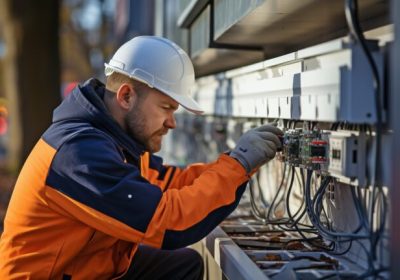Many homeowners, businesses, and municipalities use video surveillance to protect people and property, but does it serve that purpose effectively?
Statista reports that the global market for video surveillance is projected to climb to $62.6 billion in 2023. Clearly, security and other industries rely heavily on this technology worldwide. In this article, we’ll look at what video surveillance is, how it’s used, and what the data tells us about its effectiveness.
What is Video Surveillance?
Video surveillance is simply the use of cameras to get objective records of events or track individuals. They’re often used for monitoring high-traffic or sensitive areas where significant events could be unpredictable. While various technologies are involved in surveillance, it generally consists of a camera for monitoring and a system for storing the footage.
Surveillance Cameras
There are many options for surveillance cameras on the market. Cameras can record normal light or infrared for low-light settings, while some capture both. They can be attached to sensors or timers to determine when to start video capture. These sensors might trigger the camera based on sound, movement, or heat detection. Cameras can be mobilized to pan a specific area and follow movement.
Some newer cameras are equipped with a 360-degree field of view, facial recognition software, smartphone integration, and voice control.
Storage Systems
The two most widely used video storage structures are closed-circuit TV (CCTV) and cloud-based systems.
CCTV systems have been the standard for decades. Cameras capture video data, which is recorded on some hardware device at the location and can be accessed through onsite monitors. These systems rely heavily on hardware, including various cables, a recording device, and at least one hard drive, if not multiple servers.
Cloud-based video surveillance is relatively new with high-speed internet. It takes the video from the camera and sends it through the existing internet connection to a server somewhere else. It requires much less hardware on-site, but it does need reliable internet access.
Which system is right for you? That largely depends on what technology with which you’re most comfortable. Many security officers are well acquainted with the CCTV platform because it’s been around for so long. The hardware requirements do make it a bit more pricey. Cloud-based systems are newer, so employees may need some retraining, but the cloud is increasingly present for many different applications.
How is Video Surveillance Used?
There are many ways we can think about the benefits of video surveillance, often in concert with other security measures. Here are a few ways we’d articulate the purposes of video surveillance in homes, businesses, and communities, though there are probably hundreds of uses.
Home defense: Whether you’re at home or away, video monitoring can offer 24/7 peace of mind.
Assists in security coverage: It reduces the number of security personnel needed for large areas and gives them improved visibility.
Loss protection: Video helps prevent shoplifting and employee theft and serves as evidence for prosecution.
Criminal investigations: When criminals succeed and get away, video surveillance helps identify and catch them.
Vandalism deterrent: People are less likely to intentionally damage property if they know they may be held accountable for it.
Operations monitoring: Video allows managers to review the efficiency of their processes and develop improvements.
Patient safety: Hospitals use video surveillance to track patients, babies, and visitors to ensure everyone’s safety.
Public safety: Cameras in public areas can help deter crimes and provide evidence of events when people break the law.
Outdoor perimeter security: Video monitoring protects property and buildings from trespassers, vandals, and thieves.
Event video surveillance: Cameras monitor crowds and capture theft, acts of violence, and other illegal activity that may put others in danger.
Parking lot security: Video surveillance protects vehicles and catches other unlawful activity.
Dispute settling: Video data is an unbiased record of accidents, violent conflicts, and other accusations that may or may not be reported accurately.
Traffic monitoring: Video is an economical way to track traffic flow and catch rule breakers.
Does Video Surveillance Work?
If video surveillance can effectively meet each of these functions, it is justifiable for people and organizations to have invested so much in these systems. But do they work as intended and as claimed?
Does Video Surveillance Prevent Crime?
The data suggests that cameras are very effective in preventing crime. A 40-year review found that where cameras were present, crime decreased significantly. The starkest effects on the crime rate occurred in car parking facilities and residential settings. But deploying other security measures along with video made the effect even larger.
Does Video Surveillance Make Workers More Productive?
This seems to be another confirmed benefit of video surveillance. MIT researchers found that letting employees know they were being watched increased profit by 7%. Workers became more conscious of their activities while at work.
Of course, work culture also has a significant impact on productivity. If surveillance isn’t done respectfully within a broader policy embracing a growth mindset, employees may become less motivated in the long term.
Does Video Surveillance Hold Up in Court?
Video evidence is generally considered superior to human memory of events, and sometimes it is the deciding factor in court cases. But it has to be done correctly.
- It needs to be acquired legally. In most states, people need to give consent to be recorded. The video may not be admissible as evidence if you don’t have it in writing. This doesn’t apply where someone is in a place they shouldn’t be.
- Video needs to include context: what happens before and after the alleged crime and a clear and accurate timestamp.
- The video quality needs to be good. Evidence that’s too blurry or dark won’t serve you in court.
Suppose you have a professionally installed, well-maintained surveillance system in your home or business. In that case, chances are you won’t need to worry about any of these problems when using the footage in court.
Groove Technology Solutions Can Install Your Perfect Video Surveillance System
If you’re ready for video surveillance in your home, business, or community, remember that effective installation is key to success. Groove has the experience to do it right and to train you and your staff on how to use your system to take full advantage of its capabilities. Contact us today and let us know about your needs, and we’ll get you a comprehensive estimate.


